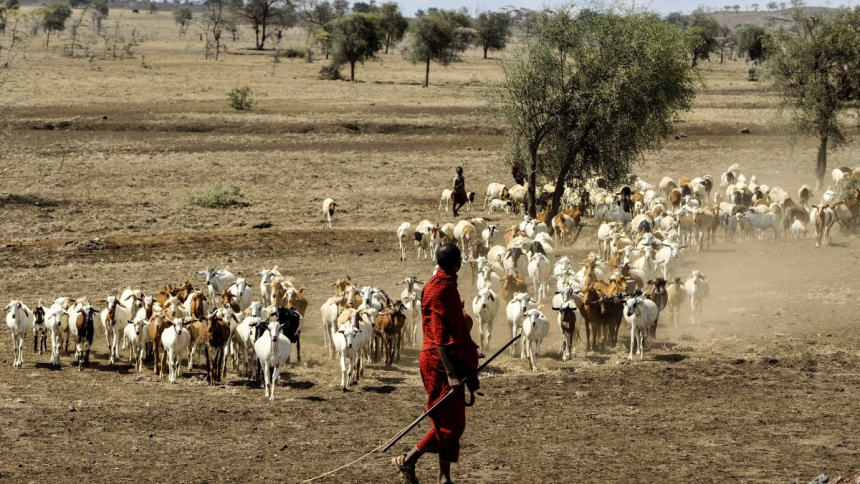Peste des petits ruminants virus (PPRV), also known as sheep and goat plague virus, causes a contagious disease of high morbidity and mortality in sheep and goat populations. PPRV is from the genus Morbillivirus, which includes other well-known infections such as human measles virus and rinderpest (cattle plague). PPRV is spread by direct contact with infected hosts, aerosols, or objects in the environment that can carry infection. Currently, PPRV has spread to more than 70 countries in Asia, the Middle East, and Africa and it threatens 80% of the global sheep and goat population of nearly 2 billion animals. Although an animal disease, PPRV also impacts human lives, as the livelihoods of over 330 million farmers rely directly on sheep and goats.
PSU researchers Catherine Herzog, Ottar Bjørnstad, Isabella Cattadori, Vivek Kapur, and Peter Hudson used a large serosurvey of sheep, goats, and cattle (n = 7,538) to investigate the distribution of PPRV seroprevalence (presence of antibodies indicated past infection) and risk factors impacting PPRV transmission. Serum samples were tested for the presence of PPRV antibodies and household surveys were collected from 11 pastoral and 9 agropastoral villages in the Arusha, Kilimanjaro, and Manyara regions of northern Tanzania during 2016. These villages represent two different livestock management systems: pastoral, in which human livelihoods rely solely on livestock, and agropastoral, in which human livelihoods rely on a mix of both crops and livestock.
The researchers found that PPRV seroconversion was widespread yet varied among sheep, goats, and cattle across the landscape. The unadjusted overall seroprevalence was 21.1% for all three species, and it differed with management practice (agropastoral villages: 5.8%, pastoral villages: 30.7%). At a species level, seroprevalence was 26.2% in sheep, 28.8% in goats, and 11.3% in cattle. Seroprevalence increased across age groups, with the oldest age groups reporting 53.6%, 46.8% and 11.6% in sheep, goats, and cattle, respectively. The researchers used generalized linear mixed models within a catalytic framework to determine significant risk factors and to estimate the force of infection (the per capita infection rate of susceptible hosts) and reproductive number (number of other individuals that one infectious individual infects, on average). Seroconversion varied significantly by management system, sex, and species. In the model containing all three species, the hazard ratio of seroconversion was 3.8 times higher in pastoral management systems than in agropastoral systems. In single species models the hazard ratio was 9.4, 9.5, and 4 times higher for sheep, goats, and cattle in pastoral management systems than in agropastoral systems. These findings highlight the critical importance of livestock management practices in disease transmission.
Unlike many other studies, this study included cattle, which are not thought to be an important host for PPRV transmission yet are often managed alongside sheep and goats. The 11.3% seroprevalence found in cattle in this study is consistent with other studies. Intriguingly, there was also strong, positive association in village-level force of infection estimate between sheep and cattle and goats and cattle, which may indicate a more important role for cattle in PPRV transmission than previously realized. Future longitudinal field studies of viral excretion and species contact patterns as well as experimental studies would better elucidate the role of cattle in this multi-host system.
This research provides valuable insights into a unique, multi-host disease system that can be applied not only to PPRV but other infectious diseases among livestock. These insights may be used to develop improved control strategies through feasible changes in non-vaccination practices, geographical areas and host species to target, and discovery of additional ecological mechanisms driving PPRV seroconversion.
Synopsis written by Catherine Herzog, MPH
Photo Credit: pxhere
Publication Details
CM Herzog, WA de Glanville, BJ Willett, TJ Kibona, IM Cattadori, V Kapur, PJ Hudson, J Buza, S Cleaveland, ON Bjørnstad
Pastoral production is associated with increased PPR seroprevalence in northern Tanzania across sheep, goats and cattle
Journal: Epidemiology and Infection
https://doi.org/10.1017/S0950268819001262
DOI Reference




